Rare Antique Solid 18K Gold Imperial Russian Faberge Egg Victor Mayer Amber Ruby
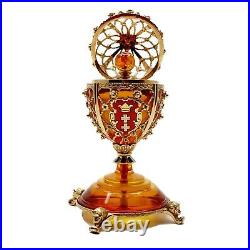
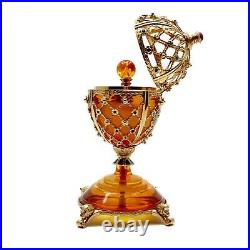
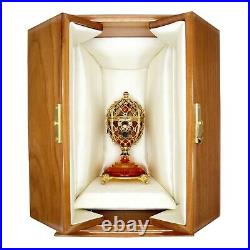
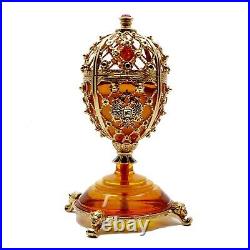

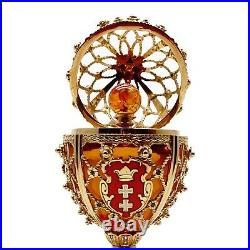
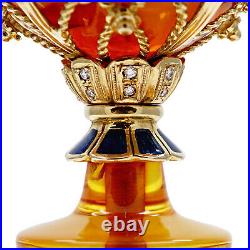
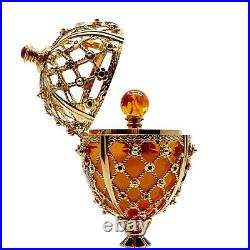
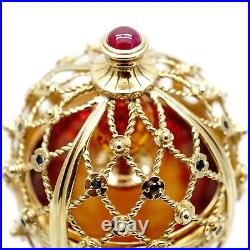
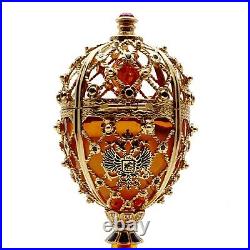
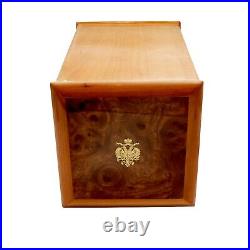
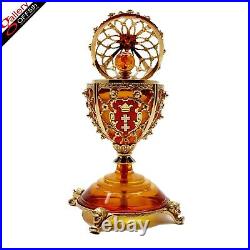

Rare Antique Solid 18K Gold Imperial Russian Faberge Egg Victor Mayer Amber Ruby. This product data sheet is originally written in English. For your consideration is an exceedingly rare and historically important authentic solid 18K yellow gold and diamond/ruby gemset Faberge Egg by Faberge workmaster, Victor Mayer (Germany).
This particular Victor Mayer Faberge Gdansk Amber Egg is limited to 07 pieces worldwide. Five pieces were manufactured without the applied 18K gold and enamel shield with Royal Coat of Arms, making this egg one of only two in existence. This egg is number 05/10; however, in accordance with the official book / catalog published by Victor Mayer in 1999, only seven eggs of this design were actually produced. Number 01/10 of this egg is on display at the Amber Museum, located in Gdansk, Poland.
For serious buyers and collectors, there are a few video clips of the Faberge Amber Gdansk Egg on display at the Amber Museum, available on YouTube. The original Faberge burlwood presentation box is included. There is some minor oxidation to the clear coat of the original burlwood presentation box, which is consistent with the age of this production. The original certificate / book of authenticity is included. The base of this egg is made of the finest solid 18k gold and hand-carved natural Russian / Polish Baltic Sea amber available, featuring absolutely exquisite solid 18K gold / enamel / diamond / ruby construction.The Faberge 18KT Gold Gdansk Amber Egg by Victor Mayer features natural Diamonds - 0.20 ct. Natural blue Sapphire -1.46 ct. And solid natural unheated / treated Amber accents. Net weight is 202.0 grams.
Height from the top to base 11.50 cm. Height of the Pendant 6.20 cm. Diameter of the Pendant 4.80 cm.
Diameter of the base: 8.0 cm. It is estimated that 150 grams of 18K gold was used to create this masterpiece. The famous jeweler to the Tsars, Peter Carl Faberge, usedso called "workmasters" to create his wonderful objects of art. The Faberge Company, then in St.
Petersburg, now has offices in London, Paris, and New York, to continue this tradition. In 1990 the Faberge Company appointed the jeweler Victor Mayer GmbH & Co. Of Pforzheim, Germany, founded in 1890, as the new and exclusive Faberge workmaster. This firm was chosen because throughout more than 100 years it has continued to maintain the essential manual skills and technical knowledge necessary for the continuation of Faberge's legacy. Under one roof 60 craftsmen exercise more than 30 traditional skills - some of them unique to this firm.Victor Mayer of Pforzheim, Germany is the only work master in the world that has been entrusted with the license to produce and sell Faberge Company enameled 18k gold jewelry. Every item created is an original work produced in a limited edition and bears the coveted FABERGÉ hallmark andthe mark of workmaster Victor Mayer. The family owned enterprise, Victor Mayer GmbH & C, wasfounded in 1890 and is one of Europe's leading producers of handmade jewelry. In more than 30 countries the name of the company founder is synonymous with the craft of the German goldsmith. Creations from Victor Mayer are the result of an unusual combination of tradition and innovation.
Their greatest asset is an archive of designs, models, and work books as well as specialty tools and equipment from 110 years of company history. Thanks to the knowledge handed down to the fourth generation, the craftsmen at Victor Mayer are able to use rare techniques of the goldsmith's art to produce incomparable jewelry and objects of art for Faberge. Victor Mayer was a Fabergé workmaster, the term used for the overseer of the workshop and craftsmen, from 1990 until 2015. Mohr, a fourth generation Mayer, Victor Mayer created a new generation of eggs, starting with the first post-revolutionary egg presented to Mikhail Gorbachev as he received the Nobel Peace Prize in 1991, the Gorbachev Peace Egg.
The eggs are the most complicated objects that Victor Mayer manufactured under the Fabergé label (it also manufactured enamel jewelry, watches, and other objets d'art). Victor Mayer (1857 in Pforzheim, Germany - 1946) founded the jewelry manufacture Victor Mayer in Pforzheim in 1890. In the time of Jugendstil / Art Nouveau, the company created pieces based on the designs of well-known artists such as the jewellery designer Professor Georg Kleemann or Anton Krautheimer of the Munich Secession.
In the art deco period and in the1950s the manufacture focused mainly on fine gold and silver ware. From the 1970s onwards again more jewelry was manufactured. Until 1989 the company produced Fabergé jewelry for Fabergé & Cie in Paris.
The manufacture Victor Mayer is well known for its high-end jewelry and the preservation of historical artisan techniques such as authentic fire enamel and guilloche. Victor Mayer was born in 1857 into a family of thriving entrepreneurs. Between 1872 and 1877, Victor Mayer served as an apprentice where he underwent the training to become a steel engraver. Then he became one of the first students at the Pforzheim Arts and Crafts School (PforzheimerKunstgewerbeschule) founded in 1877 by Grand Duke Friedrich I. After having completed his military service from 1879 until 1882, he could finally set off for a three-year stay in Vienna, which he had planned for a long time.There he gained valuable experience in enameling and guilloche-engraving, sophisticated techniques which are still being used at the manufacture Victor Mayer today. After returning to Pforzheim, he continued his studies at the Grand Duke's Artand Crafts School and received significant commendations in drawing, modelling and design. In 1890 he married Lina née Niemand.
In the same year he founded the jewelry company Vogel & Mayer in Pforzheim together with the merchant Herrmann Vogel. Herrmann Vogel left the company in 1895 after conflict arose between the partners, and Victor Mayer continued the business alone under hisown name.
In 1932 he withdrew from operative business and handed over his shares in equal parts to his son Oskar Mayer and his son in law Edmund Mohr. Victor Mayer died in Pforzheim on 13 October 1946. Victor Mayer's creative works embrace four periods. He began in 1885 in the style of historicism at the Arts and Crafts School in Pforzheim, progressing towards the Jugendstil / Art Nouveau in the early 1900s, moving onto Art Deco after the First World War.
With his late avant-garde designs created after 1940, he pointed the way forward to the 1950s. The manufacture Victor Mayer GmbH & Co. KG was foundedin 1890 by Victor Mayer and Herrmann Vogel. After Herrmann Vogel had left the company in 1895, Victor Mayer continued the business alone under his name.
Histwo oldest sons, Victor and Julius, died in World War I. They had been designated to take over the company management from the founder. Now two of the remaining children, Maria and Oskar Mayer, had to assume the commercial tasks in the company, while Victor Mayer was in charge of the technical management and design. Maria married Edmund Mohr, who became an individually liable partner and co-owner of the company in 1925. In 1932 Victor Mayer withdrew from operative business and handed over his shares in equal parts to his only remaining son Oskar Mayer and his son in law Edmund Mohr.
Until 1965 Oskar Mayer and Edmund Mohr were equal partners and responsible co-owners of the company. In this year the two grandsons of Victor Mayer, Dr. Herbert Mohr-Mayer and his cousin Hubert Mayer, took over the management of the company. When Hubert Mayer died unexpectedly in 1989, Dr.
In 1989 the company obtained the license to manufacture Fabergé jewelry and objects of art and achieved great success with these pieces until 2009. Herbert Mohr-Mayer left the company and his son Dr. Marcus Oliver Mohr became creative director and managing partner.
The great-grandson of Victor Mayer is now leading the business in the fourth generation. In 1996 Fabergé jewelry by Victor Mayer was shown together with the works of Peter Carl Fabergé at the Metropolitan Museum, New York. The collection of Fabergé Eggs was the center piece of the Russian Pavilion at Expo2000 in Hannover, Germany. A Return To Russia was the name of an exhibition staged at the Moscow Kremlin's Armory in 2001. On display were some thirty pieces of jewelry created by Victor Mayer.The Faberge Gdansk Amber Egg by Victor Mayer was one of the thirty eggs exhibited in the collection. This item is in the category "Collectables\Decorative Collectables\Other Decorative Collectables". The seller is "galleryoff5th" and is located in this country: US. This item can be shipped worldwide.
- Style: Imperial
- Features: Gemset
- Country/Region of Origin: Germany
- Color: Gold
- Brand: Faberge
- Material: Gold
- Primary Material: Gold
- Original/Reproduction: Original
- Age: Post-1940
- Era: Vintage
